20 Best Horror Movies of All Time
They make our heart beat faster, scare us, frighten us, and yet we love to watch them. What horror films can be counted among the best horror films in the history of cinema?
Horror is one of the oldest film genres, and its pedigree is complex. After all, the origin of this type of cinema consists of motifs from romantic horror literature, folk tales about ghosts, vampires and werewolves, as well as inspiration from the art of expressionism in the early 20th century. The discoveries of psychoanalysis were also an important factor in the development of this convention.
The features of horror films were fully codified in the 1930s in American cinema. The genre was primarily specialized in by Universal. The fourth decade of the twentieth, in turn, brought a completely new type of horror film, namely one in which the main theme was not the story of a menacing monster, but the mysterious atmosphere of the film came to the fore. Works of this type were produced by Val Lewton; among them we can mention, for example, “Cat People” (1942) or “The Seventh Victim” (1943).
In the following decades, new horror conventions were created. Nowadays, the genre has many varieties, such as stories about monsters or mutated animals, gore horror films abounding in a large number of gory scenes (D. Cronnenberg, G. Romero, W. Craven specialize in them), satanic horror films or series about a demonic hero, such as Freddy Krueger.
The best horror movies of all time
1. “Nosferatu. A Symphony of Horror” (1922)
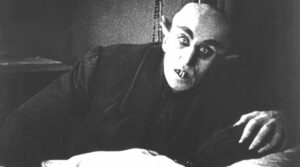
“Nosferatu. A Symphony of Horror” is Friedrich Wilhelm Murnau’s unforgettable 1922 film. The silent cinema immersed in the poetics of German Expressionism still impresses audiences today. The film tells the story of a young merchant Thomas Hutter (Gustav von Wangenheim), who accepts a job offer from a ghostly count in the Carpathian Mountains, thereby unwittingly attracting the bloodthirsty vampire Nosferatu to his town. The title role was played by Max Schreck.
Murnau’s famous work laid the foundations of modern horror and, at the same time, launched the extremely popular films about vampires. Both the figure of the bloodthirsty monster and the blood here have a symbolic dimension. They refer to the issue of sexual taboos and the figure of the alien attacking the social order of the Western world. It is significant that in recent horror films with this theme, vampirism changes its meaning – it becomes a kind of epidemic, reflecting modern fears of blood-borne diseases.
2. “Dawn of the Dead” (1978)
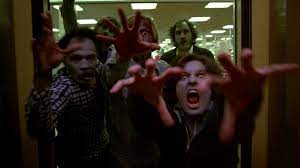
“Dawn of the Dead” is George Romero’s excellent 1978 horror film and also a sequel to Night of the Living Dead. The work is an example of zombie horror, its plot is set in a shopping mall, where a group of heroes are attacked by the dead coming back to life. The main roles are played by Ken Foree, Tom Savini and Gaylen Ross.
This classic of zombie films presents a slightly different diagnosis of the dangers of civilization than stories about vampirism. After all, a zombie is a captive monster, devoid of higher consciousness, which is a metaphor for all kinds of mental enslavement. It can be political, for example, as well as social (such as modern consumerism).
3. “Psycho” (1960)

Alfred Hitchcock’s “Psycho” (1960) is also a classic of horror cinema. Seemingly peaceful boarding house owner Norman Bates (played by Anthony Perkins) turns out to be a deadly murderer possessed by the darkness of his own diseased mind. A series of tragic events is set in motion by the appearance at the motel of a young girl with a suitcase of stolen money (Janet Leigh). Psycho is not a typical horror film, but a characteristic Hitchcock thriller, with all the hallmarks of a master: long camera shots, suspense and tension reaching its zenith.
Hitchcock’s famous movie is a clinical example of the use of a psychoanalytic key to interpret human behavior. The director uses this method especially to show the protagonist’s pathological relationship with his mother, but also prompts the viewer to psychological self-reflection. Therefore, the film of the master of suspense becomes a kind of self-therapy tool for the viewer.
4. “Jaws” (1975)

It’s hard not to mention Steven Spielberg’s “Jaws” (1975) among cult horror films. The director constructs a story about a bloodthirsty ludo shark that finds more victims in Amity Island. The monstrous creature is confronted by shark hunter Quint (Robert Shaw), Sheriff Brody (Roy Scheider) and oceanologist Hooper (Richard Dreyfuss). “Jaws” is a heartwarming story of the clash between man and the power of nature, which lived to see a sequel in the form of subsequent parts.
Interestingly, “Jaws” was supposed to premiere on Christmas Day, but due to problems with the mechanical monster, shooting was extended and the film didn’t come out until June. This was a landmark event, as it marked the beginning of the “summer blockbuster” phenomenon.
5. “Rosemary’s Baby” (1968)

Among the best horror films, Roman Polanski’s “Rosemary’s Baby” (1968) holds a special place. It is a satanic film, dealing with the presence of demonic forces in the world. Rosemary, played by young Mia Farrow, is the wife of a promising actor (John Cassavetes). The woman and her husband move into a mysterious apartment building inhabited by bizarre neighbors, and soon discovers that she is pregnant. Rosemary’s Baby is a great horror film that can be interpreted on many different levels, and is patronized not only by the director’s fascination with demonology, but also by clear inspirations from psychoanalysis.
“Rosemary’s Baby” is the first film made in the US by Roman Polanski, which, in addition, turned out to be a work that assures the director a permanent place in the history of cinema. As a horror film initiating a transformation within the genre, the picture grew out of a crisis of Christian values, but at the same time showed the essential need of a secularized society: the search for a foothold in old rites and rituals. To this day, the story of the film’s creation, and especially the episode of collaboration with occultist Anton LaVey, author of The Satanic Bible, are shrouded in some mystery. They also take on special significance in the context of Polanski’s subsequent personal life.
6. “The Shining” (1980)
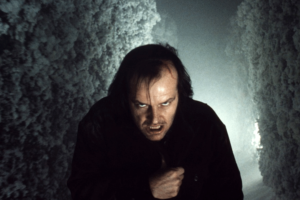
“The Shining” (1980) is a cult horror movie directed by Stanley Kubrick. Jack Torrance (played by Jack Nicholson), along with his wife (Shelley Duvall) and son (Danny Lloyd), move into the deserted Overlook Hotel for the winter to take care of it during the tourist boom. At the same time, Jack gains the perfect opportunity to finish his novel. Unexpectedly, however, the stay turns into a nightmare, and demonic forces creep into the lives of the characters. The Shining is a film about the dark side of the human mind, which can lead to self-destruction.
One of the most famous horror films of all time completely disliked the author of the literary original, Stephen King. Interestingly, the audience also did not immediately love Kubrick’s film. This is because the director made the film in a rather unusual way for the cinema of the genre: he limited any supernatural horror elements in favor of highlighting the “ordinary” problems of the characters. It is these, in a situation of isolation from the world, that rise to the level of horror. A seemingly innocent sentence typed by a man, “Constant work without fun spoils Jack’s mood,” unexpectedly gains a completely different dimension, exposing the growing psychosis of a writer plunged into alcoholism and creative crisis.
7. “The Texas Chain Saw Massacre”

“The Texas Chain Saw Massacre”, directed by Tobe Hooper, is an example of the horror gore genre. The leitmotif of the film and its sequel is the titular murder committed by a psychosis-stricken man named Leatherface (Gunnar Hansen) on a group of random teenagers. “The Texas Chain Saw Massacre” shocks the viewer with brutality, the sight of bloody torture and an atmosphere of fear.
Hooper’s horror movie was one of the first films to introduce new means of expression to cinema, aiming to render the details of the crime as closely as possible. These included, for example, the slow motion technique, exposing details or the very characteristic use of “squibs” (hidden containers of red liquid imitating gushing blood). Such a way of showing crime in the cinema was associated with weakening censorship and ejaculating the public with a huge dose of reports of violence – in the press and on television. The social context of the film’s creation – the times of the counterculture – was also important. For this reason, it is possible to read “The Texas Chain Saw Massacre” as a picture of the ruthless struggle between the traditional patriarchal order (represented, after all, by a pathological family of cannibals) and the ideas of the hippies (young tourists).
8. “The Exorcist” (1973)
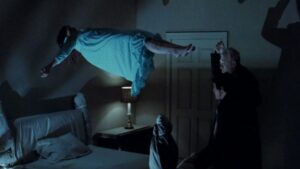
“The Exorcist” (1973), directed by William Friedkin, is a film set in the realm of satanic horror films. For it tells the story of a girl Regan (Linda Blair) possessed by an evil spirit. She is helped by priest Damien Karras (Jason Miller) and exorcist Merrin (Max von Sydow). The Exorcist is a cult horror film that has had a profound impact on the poetics of horror films and has become a permanent fixture in pop culture.
Later in relation to “Rosemary’s Baby”, the horror movie no longer shows the shaky position of Christianity, but the open struggle between the secular and religious vision of society. The film has a parabolic dimension and was already read at the time of its release as a story about the American situation. It is significant that the battle for the soul of the child here must be fought by Father Karras, himself experiencing a crisis of faith.
9. “A Nightmare on Elm Street” (1984)

Wes Craven’s horror film launched the cult series of Freddy Krueger movies. In an American town, teenagers begin to dream about a scary man with a burned face and a hand equipped with sharp metal claws. It soon turns out that the nightmares are not just a figment of children’s imagination, but have real consequences. The terrifying murderer kills more young and defenseless victims.
In 2003, Freddy Krueger, played by Robert Englund, ranked 40th on the American Film Institute’s list of the 100 greatest heroes and villains of all time. It is worth noting that Craven’s cult horror film has multi-story symbolism. For example, it can be read as a camouflaged tale of pedophilia, as indicated primarily by the choice of victims, but also by the fact that the monster attacks them at night, in a child’s bedroom, while they sleep.
10. “Carrie” (1976)
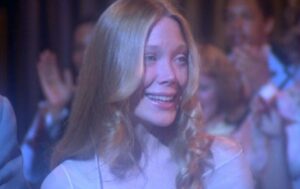
The list of cult horror films certainly can’t miss 1976’s “Carrie”, directed by Brian De Palma. The movie was based on the novel by Stephen King, published two years earlier. The title Carrie (Sissy Spacek) is a seventeen-year-old girl misunderstood by her fanatically religious mother (Piper Laurie) and persecuted by her peers. When the heroine is once again humiliated at her prom, she reveals her supernatural abilities, which she uses against her tormentors.
“Carrie” shows the very process of adolescence as a kind of horror movie – an extremely difficult period when a person has to build his or her identity, face social, cultural and religious pressures, and learn to defend his or her position within the framework of commonly accepted measures. At the same time, Brian De Palma’s film contains clear autothematic allusions – it is a statement about cinema itself, as the art of telling still similar and yet different stories with images, and about his own work.
11. “Suspiria” (1977)
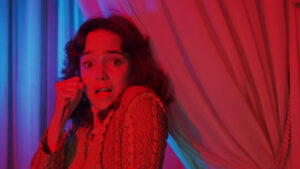
The best horror films of all time are not only American productions, but also European films. In the 1970s, the current of Italian horror films was particularly popular, among which the most outstanding work is Dario Argento’s famous “Suspiria“. The picture begins the “Three Mothers Trilogy”, inspired by Thomas de Quincey’s 1845 work “Suspiria de Profundis”. The film’s main character is English teenager Susy Bannion (Jessica Harper), who arrives at an elite German boarding dance school. Soon, horrific things begin to happen at the academy, and more people die horrible deaths.
“Suspiria” is a masterpiece in terms of visual and musical composition. The events unfolding in the film are emphasized by the intense, contrasting colors realized using the Technicolor method by cinematographer Luciano Tovoli. Painting inspirations are evident here, as well as the creation of a fairy-tale atmosphere by means of light and the musical layer. In turn, the impression of horror is heightened by whispers and screams reaching the viewer’s ears. The title of the horror film itself comes from the name of the witch the heroine has to face – Mater Suspiriorum (Mother of Sighs of Freiburg).
12. “Friday the 13th” (1980)

Among the scariest horror movies, the iconic “Friday the 13th” is certainly worth mentioning. The series was launched in 1980 by Sean S. Cunningham. The first installment is set at Crystal Lake, where a series of brutal and unexplained murders of teenagers took place years ago. When the site is acquired by entrepreneur Steve Christy (Peter Brouwer), against the resistance of the local community, a youth camp is to be built on the site again. The man hires several young helpers to get everything ready for the season. However, no one suspects that the whole group will soon be attacked.
“Friday the 13th” is, next to John Carpenter’s Halloween, the most famous slasher of the 1970s. In each successive installment, young people become the victims of an attack by a ruthless killer who carries out brutal acts in a place located far from civilization. Teenage sex life plays an important role in Cunningham’s film. It is subject to strict social evaluation, and for their moral freedom the characters are, so to speak, “punished” by a psychopathic killer.
13. “Interwiev with the Vampire: The Vampire Chronicles” (1994)
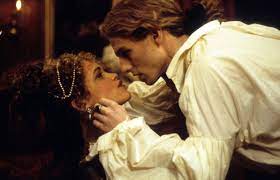
“Interview with the Vampire” (1994) by Neil Jordan is a horror movie that undertakes a conscious game with the conventions of the genre. After all, the main character, vampire Louis de Pointe du Lac (Brad Pitt), is not an entirely negative character. True, he must feed on human blood, but he does so very reluctantly, and he accepts the fate of a vampire from a certain Lestat (Tom Cruise) in order to forget his suffering after the loss of his beloved wife. Interview with a Vampire raises questions about the origin of evil and its role in human life. After all, paradoxically, the vampire Lestat, like Satan in Goethe’s Faust, turns out to be an evil who, in spite of his own nature, does good – saves man from despair.
The film is based on Anne Rice’s novel, in which, interestingly, vampirism was read as a metaphor for a forbidden form of eroticism, specifically homosexuality. Maria Janion points to this interpretation. The sign of homoeroticism here would be the stigmatized otherness of the protagonist and his various attempts to accept his own nature.
14. “The Ring” (2002)
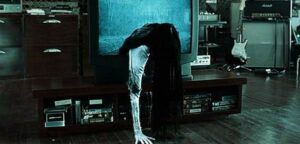
“The Ring” (2002) by Gore Verbinski is an American remake of a Japanese film. The main character of the horror film is journalist Rachel Keller (Naomi Watts), who is trying to unravel the mystery of a videotape that leads people to death. Its potential recipients have seven days to live, which is how much time the young woman has to solve the mystery and save herself and her family. The other roles were played by Martin Henderson and David Dorfman, among others. The horror film has an eerie atmosphere of mystery, the magical charm of a riddle and a psychoanalytic aura of rich symbolism.
“The Ring” has become a cult film, and the horror scenes from this horror movie have permanently entered the classics of horror cinema. The motif of a snowy TV screen, an ominous phone signal or a girl with loose hair coming out of a well are among the most recognizable images. A sequel to the popular horror film was made in 2005, directed by Hideo Nakata, also based on a script by Ehren Kruger, co-writer of the first installment.
15. “The Exorcism of Emily Rose” (2005)
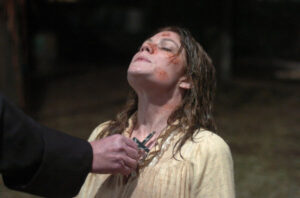
“The Exorcism of Emily Rose” is a film that belongs to the classics of satanic horror. This is because the plot is based on the theme of possession of a young girl by the devil. Moreover, the film was based on a true story, and the protagonist was a German woman, Anneliese Michel. The reality was slightly changed, and the role of Emily was played by Jennifer Carpenter. While performing an exorcism ritual, the girl dies, and Father Richard Moore (Tom Wilkinson) is brought to justice.
Scott Derrickson’s horror movie has attracted a lot of interest from fans of the genre. The course of the trial here is a telling confrontation of two different worldviews and methods of interpreting reality. Belief in the existence of metaphysics clashes with the demand for rational explanations. So, was the exorcised teenager a mentally ill girl in need of professional medical help or a demon-attacked saint?
16. “The Grudge”, 2004

Takashi Shimizu’s “The Grudge” is a Japanese-American horror movie firmly rooted in the tradition of Asian beliefs and superstitions. The main character of the film is an American girl named Karen (Sarah Michelle Gellar), who comes to Japan on a student exchange. The girl is employed at a social welfare center. One day she is asked to take care of a sick old woman. However, Karen has no idea that the woman’s house is under the influence of a terrible curse.
The horror movie is a remake of a Japanese film by the same director called Curse of Ju-On. It is one of a series of extremely popular pictures modeled on Asian horror aesthetics. The title phenomenon is explained here as follows: “If someone dies in strong anger or grief, then a curse is born, which, like a stain, accumulates at the place of death. Whoever encounters it will be consumed by its fury…”.
17. “Sinister” (2012)
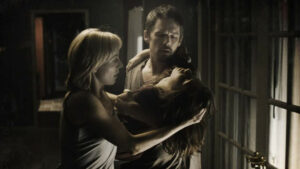
“Sinister” is another Scott Derrickson horror movie on this list, and another example of a film that offers the viewer true horror. The plot of the piece is so dense that the viewer can only breathe a sigh of relief at times, as most of the scenes are characterized by a high level of tension, taking place in dark, enclosed interiors and exuding an atmosphere of growing solitude. Sinister is a classic film about a haunted house where someone really looking for thrills moves in: an uninspired writer of crime novels (played by Ethan Hawke). It turns out, however, that even a great deal of fear resistance may not be enough to tame threatening situations.
Despite the fact that “Sinister” was constructed mostly from familiar horror cinema themes, it is a really strong entry and is among the horror films worth watching. Here we have an interesting combination of supernatural phenomena with the devices of modern technology, which, as a rule, seems to belong to the world of reason and science, not ghosts and ghouls. Meanwhile, in the film Sinister, inexplicable evil invades everywhere and lurks on man not only in the dark of night, but also in the least expected circumstances.
18. “Insidious”, 2010

James Wan made a horror movie in 2010, which turned out to be the beginning of an interesting and popular series – “Insidious”. The title refers to a young boy who falls into a coma as a result of a fall from a ladder. At the same time, strange inexplicable things begin to happen in the house. Eventually, the boy’s parents decide to take the advice of professional exorcists. It turns out that the problem is much deeper than it might seem.
Starring Patric Wilson, Rose Byrne, Ty Simpkins and Lin Shaye, who won a Saturn statuette for best supporting actress. “Insidious” draws you in with interesting action with appropriately escalating tension, and features good acting. Also, the plot solutions are ingenious and sometimes innovative, so the film launched a whole series of sequels to the spooky story of entities suspended between the world of the living and the dead.
19. “El Orfanato”, 2007
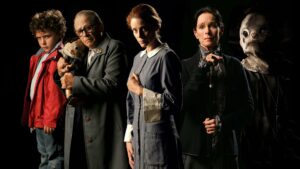
This movie is worth placing among good horror films for at least two reasons. Namely, it is an impressive Spanish production, which for obvious reasons deviates from the aesthetics of American horror cinema. Secondly, the climate of fear is built here not with stunning special effects and chilling scenes, but with simple, almost minimalist cinematic means, giving the whole thing a dimension of mystery. The main character of the horror film is Laura (Belen Rueda), who, together with her husband and adopted child, decides to live in a former orphanage, the place where she herself grew up. Soon the couple’s son starts playing with invisible friends. As it turns out, this is not just a product of his imagination.
J. A. Bayon’s “El Orfanato” has won many prestigious honors, including six Spanish Goya Awards. It was recognized not only as the best film, but also recognized the role of music, editing or costumes. Noteworthy is the supporting role of the magnificent Geraldine Chaplin, who continues to showcase her amazing acting skills here. Bayon’s horror movie is a story about the darkness of childhood, but also about the great power of love, which can overcome even supernatural obstacles.
20. “Doctor Sleep”, 2019
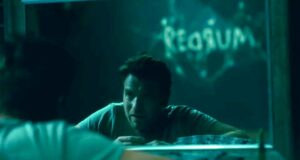
The sequel to Stanley Kubrick’s famous “The Shining” is a high-concept film in which director Mikel Flanagan tries to preserve the eerie atmosphere of the prequel, but also captures the atmosphere of Stephen King’s literary original. The main character of the horror film is Dan Torrance (played by Ewan McGregor), the son of the possessed Jack, phenomenally played in Kubrick’s version by Jack Nicholson. Now an adult, tormented by nightmares and childhood memories, he meets Abra, a girl gifted with analogous “shining” abilities. He decides to help her, as she may soon become a victim of the True Knot sect.
“Doctor Sleep” is a film in which quite ordinary human demons hide under a layer of supernatural evil. The problem is that they can be just as deadly as diabolical monsters. The protagonist has to cope, first of all, with his own trauma, an important component of which is the curse of alcoholism and the memory of paternal violence.
